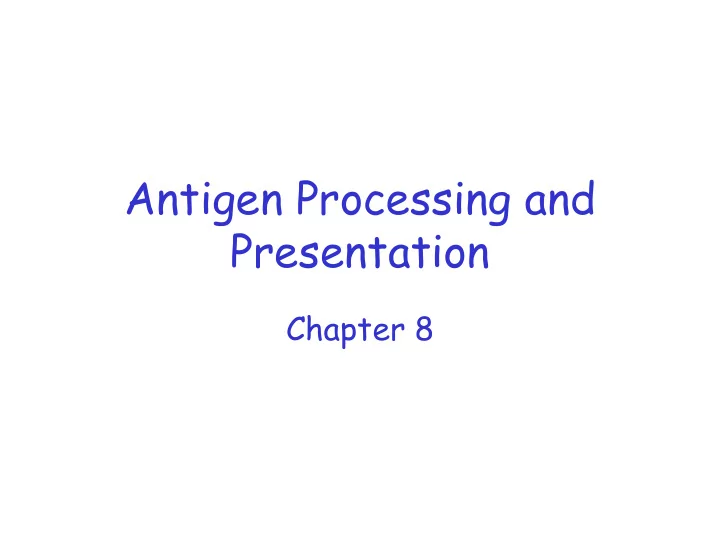

Antigen Processing and Presentation Chapter 8
Antigen Recognition by T Cells • T cells recognize linear peptides not whole proteins. • T cells only recognize epitopes when they are complexed to MHC molecules. • Therefore protein antigens must be processed and presented by other cells to be recognized by T cells. • This process is referred to as antigen processing and presentation. – Note: the association of antigenic peptides w/ MHC is a saturable, low-affinity interaction (Kd ~10 -6 M) with a slow off/on rate. • In general CD8 + T cells recognize endogenous antigens and CD4 + T cells recognize exogenous antigens. • MHC molecules bind multiple peptides, however each T cell only recognizes one peptide.
Assays for T cell Activation APC + Th + Ag Antigen Proliferation ( 3 H-thymidine uptake) Tc + Target cell +Ag Target cell lysis ( 51 Cr release) APC Th cells Tc cells Macrophage Dendritic Cell B cell “Primed T cells”
T cells Macrophage
Figure 10-18
Kloetzel, P.M., Nat. Immunol., 2004
Proteosome Produces Epitopes Poorly Ackerman and Cresswell, Nat. Immunol., 2004
Proteosome Produces Epitopes Poorly Ackerman and Cresswell, Nat. Immunol., 2004
Epitope Destruction vs. Production
Epitope Destruction vs. Production
Proteosome Produces Epitopes Poorly Ackerman and Cresswell, Nat. Immunol., 2004
Peptide Loading Complex (PLC) Ackerman and Cresswell, Nat. Immunol., 2004
HLA-DM/H-2M • Acts as a catalyst to enhance the release of CLIP • Does not bind antigenic peptides so does not act as a peptide transfer molecule • Most efficient at low pH • Acts as a peptide editor, facilitating the exchange of low stability, high off rate peptides for high stability peptides with a low off rate
Role of DM in Peptide Loading Brocke et al., 2002
Interaction of DM and DO [DM] DM + DO Stability in SDS correlates with affinity for the bound peptide; binding to CLIP is of low affinity HLA-DR3 αβ -CLIP + peptide + HLA-DM +/- HLA-DO Denzin et al., Science, 1997
MHC Class II Peptide Stability Affect T cell Stimulation t 1/2 = 86h t 1/2 = 65h t 1/2 = 26h t 1/2 = 1h
Cross-Presentation • Refers to the presentation of exogenous antigens on MHC class I molecules.
Cross-Presentation • Refers to the presentation of exogenous antigens on MHC class I molecules. • Exact mechanism is unclear; two models have been proposed: recycling and ER loading.
Cross Presentation Models Jensen, 2007
Cross-presentation: ER Model Direct access to the ER via transiently available continuities Ackerman and Cresswell, Nat. Immunol., 2004
Cross-presentation: Phagosome Model Sec61 associated phagosome Ackerman and Cresswell, Nat. Immunol., 2004
Recommend
More recommend